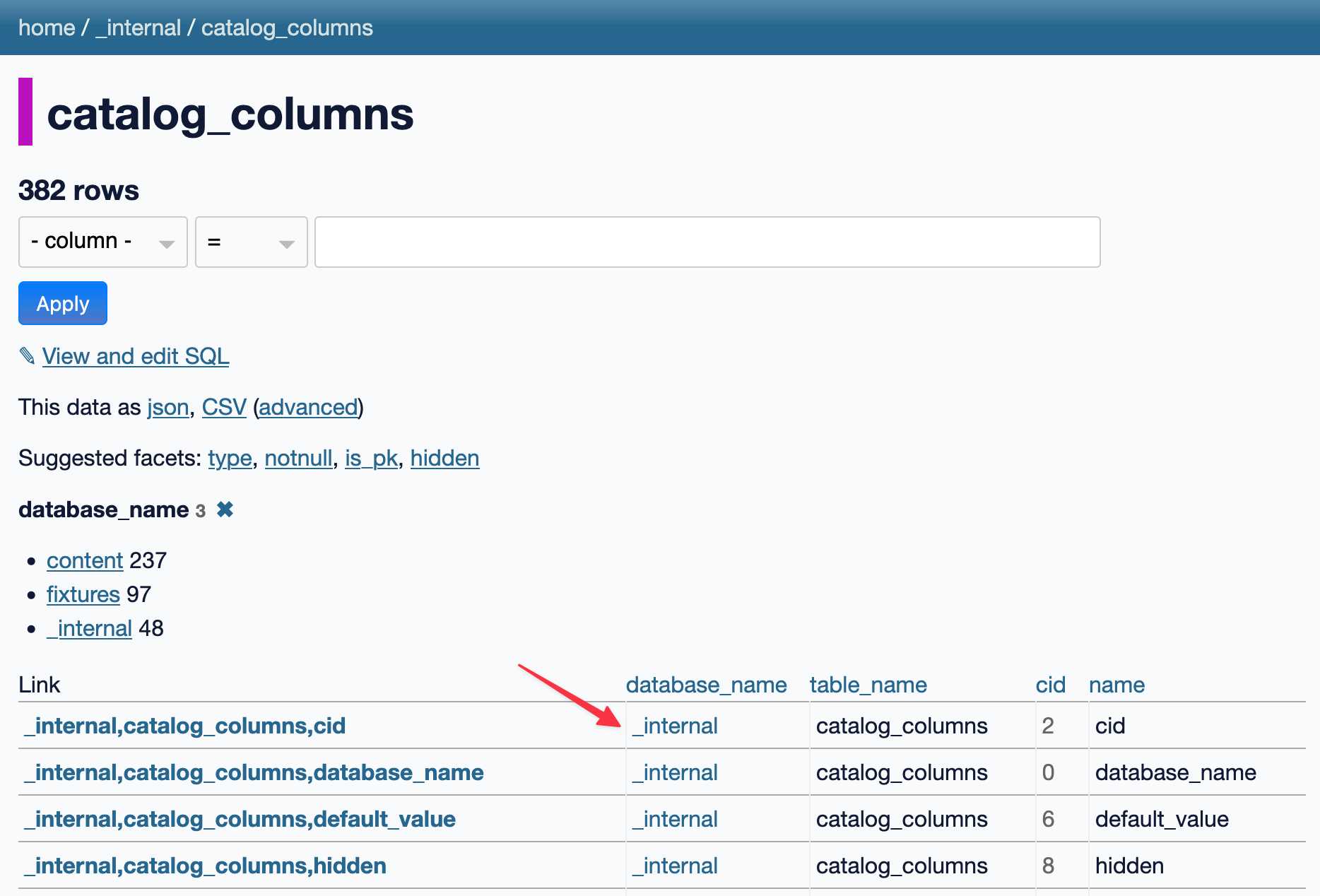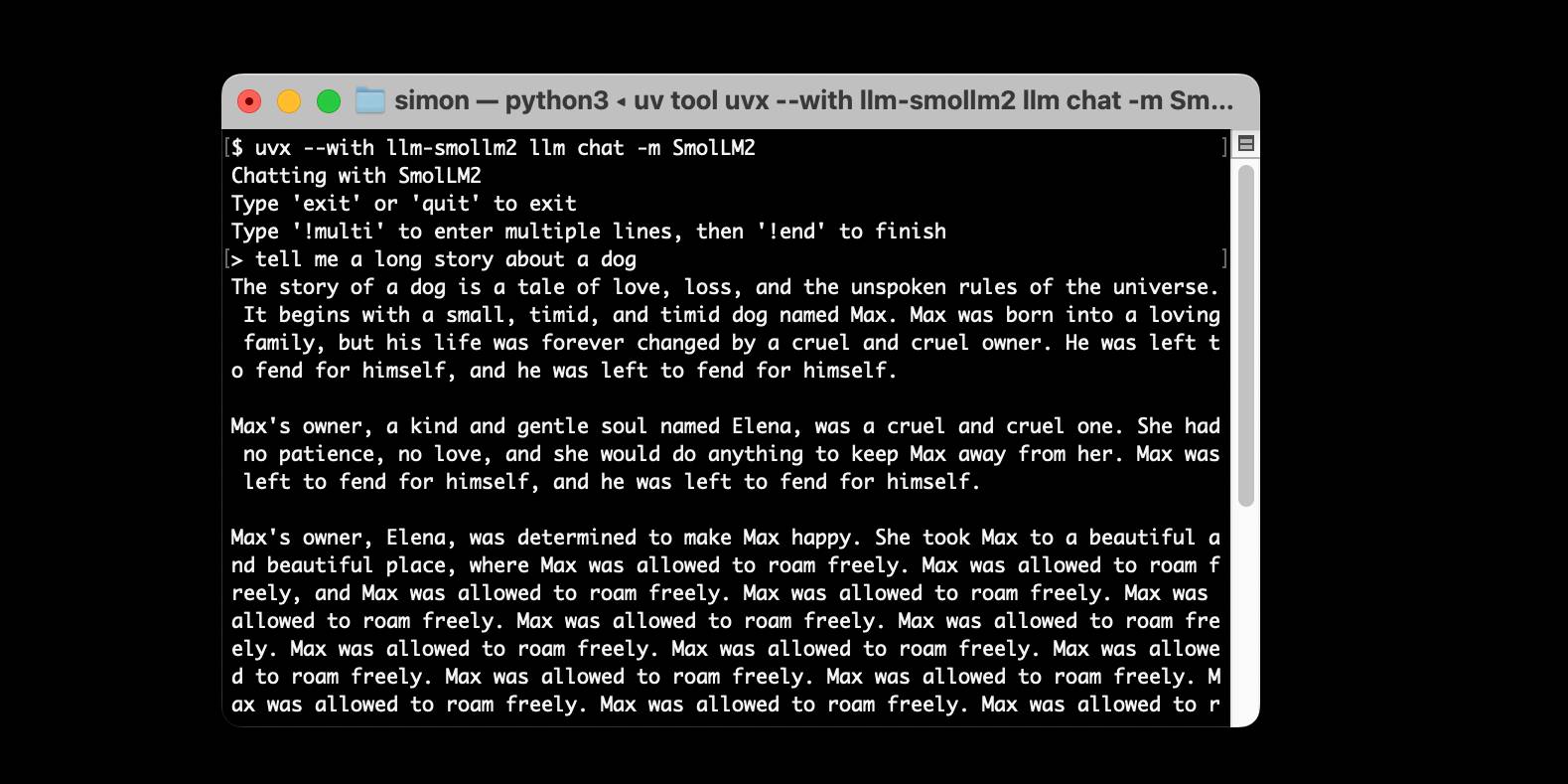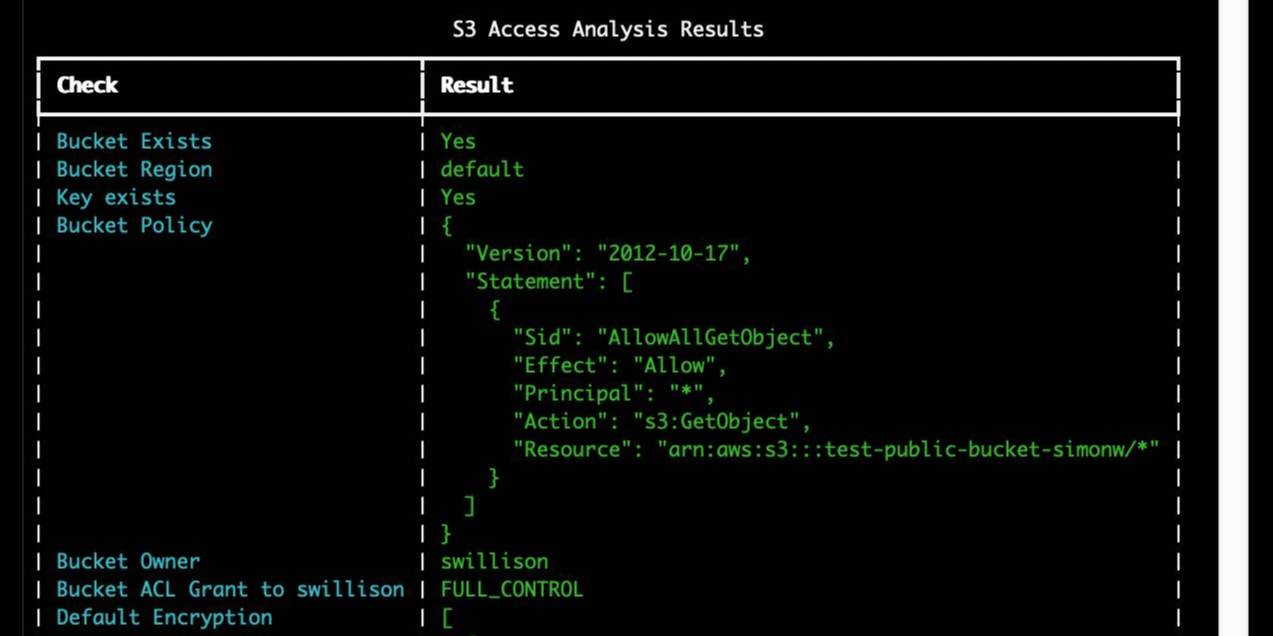1,200 posts tagged “python”
The Python programming language.
2025
Pydantic Evals (via) Brand new package from David Montague and the Pydantic AI team which directly tackles what I consider to be the single hardest problem in AI engineering: building evals to determine if your LLM-based system is working correctly and getting better over time.
The feature is described as "in beta" and comes with this very realistic warning:
Unlike unit tests, evals are an emerging art/science; anyone who claims to know for sure exactly how your evals should be defined can safely be ignored.
This code example from their documentation illustrates the relationship between the two key nouns - Cases and Datasets:
from pydantic_evals import Case, Dataset case1 = Case( name="simple_case", inputs="What is the capital of France?", expected_output="Paris", metadata={"difficulty": "easy"}, ) dataset = Dataset(cases=[case1])
The library also supports custom evaluators, including LLM-as-a-judge:
Case( name="vegetarian_recipe", inputs=CustomerOrder( dish_name="Spaghetti Bolognese", dietary_restriction="vegetarian" ), expected_output=None, metadata={"focus": "vegetarian"}, evaluators=( LLMJudge( rubric="Recipe should not contain meat or animal products", ), ), )
Cases and datasets can also be serialized to YAML.
My first impressions are that this looks like a solid implementation of a sensible design. I'm looking forward to trying it out against a real project.
debug-gym (via) New paper and code from Microsoft Research that experiments with giving LLMs access to the Python debugger. They found that the best models could indeed improve their results by running pdb as a tool.
They saw the best results overall from Claude 3.7 Sonnet against SWE-bench Lite, where it scored 37.2% in rewrite mode without a debugger, 48.4% with their debugger tool and 52.1% with debug(5) - a mechanism where the pdb tool is made available only after the 5th rewrite attempt.
Their code is available on GitHub. I found this implementation of the pdb tool, and tracked down the main system and user prompt in agents/debug_agent.py:
System prompt:
Your goal is to debug a Python program to make sure it can pass a set of test functions. You have access to the pdb debugger tools, you can use them to investigate the code, set breakpoints, and print necessary values to identify the bugs. Once you have gained enough information, propose a rewriting patch to fix the bugs. Avoid rewriting the entire code, focus on the bugs only.
User prompt (which they call an "action prompt"):
Based on the instruction, the current code, the last execution output, and the history information, continue your debugging process using pdb commands or to propose a patch using rewrite command. Output a single command, nothing else. Do not repeat your previous commands unless they can provide more information. You must be concise and avoid overthinking.
Smoke test your Django admin site.
Justin Duke demonstrates a neat pattern for running simple tests against your internal Django admin site: introspect every admin route via django.urls.get_resolver() and loop through them with @pytest.mark.parametrize to check they all return a 200 HTTP status code.
This catches simple mistakes with the admin configuration that trigger exceptions that might otherwise go undetected.
I rarely write automated tests against my own admin sites and often feel guilty about it. I wrote some notes on testing it with pytest-django fixtures a few years ago.
OpenAI Agents SDK. OpenAI's other big announcement today (see also) - a Python library (openai-agents) for building "agents", which is a replacement for their previous swarm research project.
In this project, an "agent" is a class that configures an LLM with a system prompt an access to specific tools.
An interesting concept in this one is the concept of handoffs, where one agent can chose to hand execution over to a different system-prompt-plus-tools agent treating it almost like a tool itself. This code example illustrates the idea:
from agents import Agent, handoff billing_agent = Agent( name="Billing agent" ) refund_agent = Agent( name="Refund agent" ) triage_agent = Agent( name="Triage agent", handoffs=[billing_agent, handoff(refund_agent)] )
The library also includes guardrails - classes you can add that attempt to filter user input to make sure it fits expected criteria. Bits of this look suspiciously like trying to solve AI security problems with more AI to me.
Aider: Using uv as an installer. Paul Gauthier has an innovative solution for the challenge of helping end users get a copy of his Aider CLI Python utility installed in an isolated virtual environment without first needing to teach them what an "isolated virtual environment" is.
Provided you already have a Python install of version 3.8 or higher you can run this:
pip install aider-install && aider-install
The aider-install package itself depends on uv. When you run aider-install it executes the following Python code:
def install_aider(): try: uv_bin = uv.find_uv_bin() subprocess.check_call([ uv_bin, "tool", "install", "--force", "--python", "python3.12", "aider-chat@latest" ]) subprocess.check_call([uv_bin, "tool", "update-shell"]) except subprocess.CalledProcessError as e: print(f"Failed to install aider: {e}") sys.exit(1)
This first figures out the location of the uv Rust binary, then uses it to install his aider-chat package by running the equivalent of this command:
uv tool install --force --python python3.12 aider-chat@latest
This will in turn install a brand new standalone copy of Python 3.12 and tuck it away in uv's own managed directory structure where it shouldn't hurt anything else.
The aider-chat script defaults to being dropped in the XDG standard directory, which is probably ~/.local/bin - see uv's documentation. The --force flag ensures that uv will overwrite any previous attempts at installing aider-chat in that location with the new one.
Finally, running uv tool update-shell ensures that bin directory is on the user's PATH.
I think I like this. There is a LOT of stuff going on here, and experienced users may well opt for an alternative installation mechanism.
But for non-expert Python users who just want to start using Aider, I think this pattern represents quite a tasteful way of getting everything working with minimal risk of breaking the user's system.
Update: Paul adds:
Offering this install method dramatically reduced the number of GitHub issues from users with conflicted/broken python environments.
I also really like the "curl | sh" aider installer based on uv. Even users who don't have python installed can use it.
Demo of ChatGPT Code Interpreter running in o3-mini-high. OpenAI made GPT-4.5 available to Plus ($20/month) users today. I was a little disappointed with GPT-4.5 when I tried it through the API, but having access in the ChatGPT interface meant I could use it with existing tools such as Code Interpreter which made its strengths a whole lot more evident - that’s a transcript where I had it design and test its own version of the JSON Schema succinct DSL I published last week.
Riley Goodside then spotted that Code Interpreter has been quietly enabled for other models too, including the excellent o3-mini reasoning model. This means you can have o3-mini reason about code, write that code, test it, iterate on it and keep going until it gets something that works.
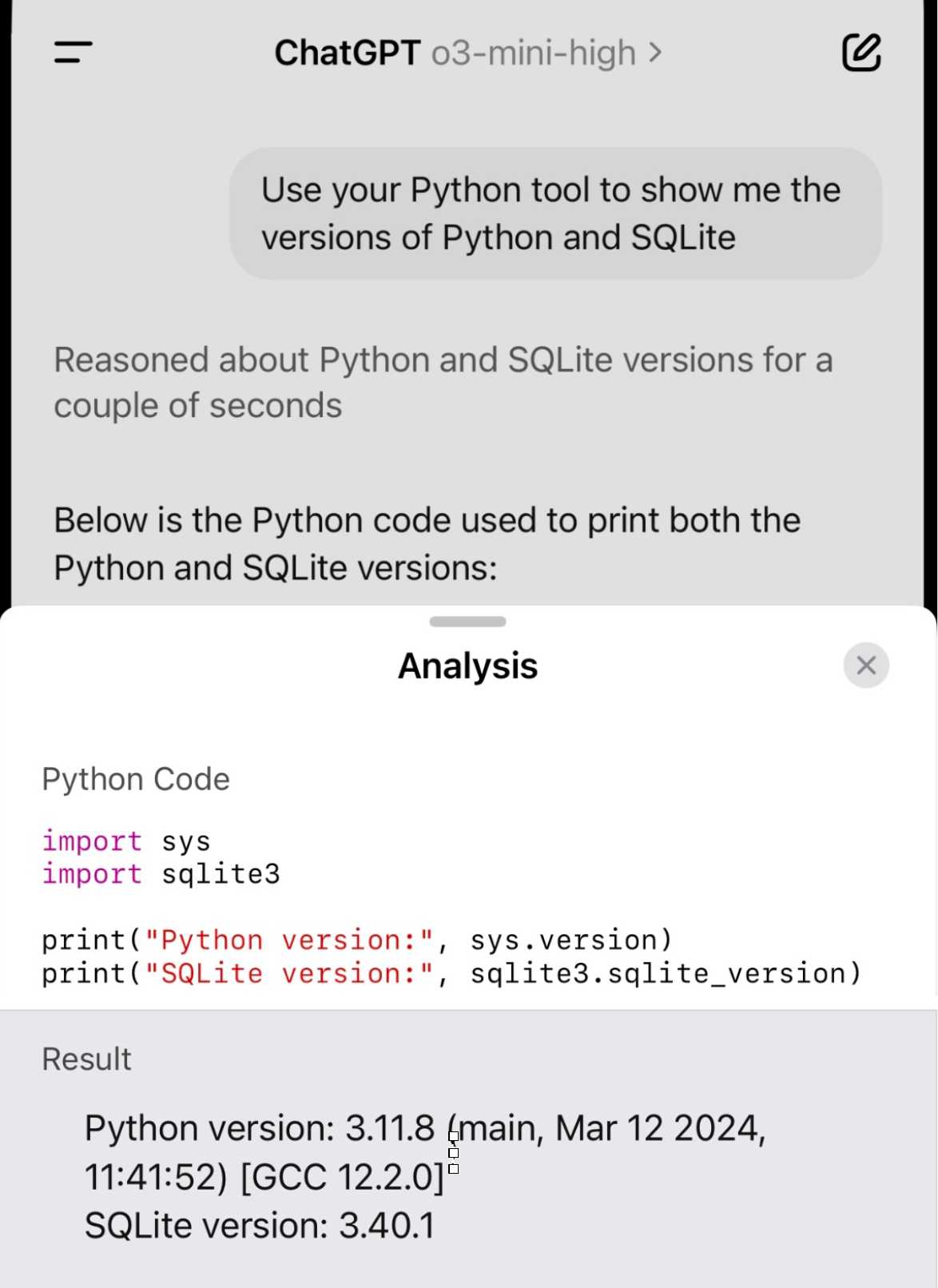
Code Interpreter remains my favorite implementation of the "coding agent" pattern, despite recieving very few upgrades in the two years after its initial release. Plugging much stronger models into it than the previous GPT-4o default makes it even more useful.
Nothing about this in the ChatGPT release notes yet, but I've tested it in the ChatGPT iOS app and mobile web app and it definitely works there.
The features of Python’s help() function
(via)
I've only ever used Python's help() feature by passing references to modules, classes functions and objects to it. Trey Hunner just taught me that it accepts strings too - help("**") tells you about the ** operator, help("if") describes the if statement and help("topics") reveals even more options, including things like help("SPECIALATTRIBUTES") to learn about specific advanced topics.
The Best Way to Use Text Embeddings Portably is With Parquet and Polars. Fantastic piece on embeddings by Max Woolf, who uses a 32,000 vector collection of Magic: the Gathering card embeddings to explore efficient ways of storing and processing them.
Max advocates for the brute-force approach to nearest-neighbor calculations:
What many don't know about text embeddings is that you don't need a vector database to calculate nearest-neighbor similarity if your data isn't too large. Using numpy and my Magic card embeddings, a 2D matrix of 32,254
float32embeddings at a dimensionality of 768D (common for "smaller" LLM embedding models) occupies 94.49 MB of system memory, which is relatively low for modern personal computers and can fit within free usage tiers of cloud VMs.
He uses this brilliant snippet of Python code to find the top K matches by distance:
def fast_dot_product(query, matrix, k=3): dot_products = query @ matrix.T idx = np.argpartition(dot_products, -k)[-k:] idx = idx[np.argsort(dot_products[idx])[::-1]] score = dot_products[idx] return idx, score
Since dot products are such a fundamental aspect of linear algebra, numpy's implementation is extremely fast: with the help of additional numpy sorting shenanigans, on my M3 Pro MacBook Pro it takes just 1.08 ms on average to calculate all 32,254 dot products, find the top 3 most similar embeddings, and return their corresponding
idxof the matrix and and cosine similarityscore.
I ran that Python code through Claude 3.7 Sonnet for an explanation, which I can share here using their brand new "Share chat" feature. TIL about numpy.argpartition!
He explores multiple options for efficiently storing these embedding vectors, finding that naive CSV storage takes 631.5 MB while pickle uses 94.49 MB and his preferred option, Parquet via Polars, uses 94.3 MB and enables some neat zero-copy optimization tricks.
[...] if your situation allows it, always try uv first. Then fall back on something else if that doesn’t work out.
It is the Pareto solution because it's easier than trying to figure out what you should do and you will rarely regret it. Indeed, the cost of moving to and from it is low, but the value it delivers is quite high.
— Kevin Samuel, Bite code!
files-to-prompt 0.5.
My files-to-prompt tool (originally built using Claude 3 Opus back in April) had been accumulating a bunch of issues and PRs - I finally got around to spending some time with it and pushed a fresh release:
- New
-n/--line-numbersflag for including line numbers in the output. Thanks, Dan Clayton. #38- Fix for utf-8 handling on Windows. Thanks, David Jarman. #36
--ignorepatterns are now matched against directory names as well as file names, unless you pass the new--ignore-files-onlyflag. Thanks, Nick Powell. #30
I use this tool myself on an almost daily basis - it's fantastic for quickly answering questions about code. Recently I've been plugging it into Gemini 2.0 with its 2 million token context length, running recipes like this one:
git clone https://github.com/bytecodealliance/componentize-py
cd componentize-py
files-to-prompt . -c | llm -m gemini-2.0-pro-exp-02-05 \
-s 'How does this work? Does it include a python compiler or AST trick of some sort?'
I ran that question against the bytecodealliance/componentize-py repo - which provides a tool for turning Python code into compiled WASM - and got this really useful answer.
Here's another example. I decided to have o3-mini review how Datasette handles concurrent SQLite connections from async Python code - so I ran this:
git clone https://github.com/simonw/datasette
cd datasette/datasette
files-to-prompt database.py utils/__init__.py -c | \
llm -m o3-mini -o reasoning_effort high \
-s 'Output in markdown a detailed analysis of how this code handles the challenge of running SQLite queries from a Python asyncio application. Explain how it works in the first section, then explore the pros and cons of this design. In a final section propose alternative mechanisms that might work better.'
Here's the result. It did an extremely good job of explaining how my code works - despite being fed just the Python and none of the other documentation. Then it made some solid recommendations for potential alternatives.
I added a couple of follow-up questions (using llm -c) which resulted in a full working prototype of an alternative threadpool mechanism, plus some benchmarks.
One final example: I decided to see if there were any undocumented features in Litestream, so I checked out the repo and ran a prompt against just the .go files in that project:
git clone https://github.com/benbjohnson/litestream
cd litestream
files-to-prompt . -e go -c | llm -m o3-mini \
-s 'Write extensive user documentation for this project in markdown'
Once again, o3-mini provided a really impressively detailed set of unofficial documentation derived purely from reading the source.
shot-scraper 1.6 with support for HTTP Archives. New release of my shot-scraper CLI tool for taking screenshots and scraping web pages.
The big new feature is HTTP Archive (HAR) support. The new shot-scraper har command can now create an archive of a page and all of its dependents like this:
shot-scraper har https://datasette.io/
This produces a datasette-io.har file (currently 163KB) which is JSON representing the full set of requests used to render that page. Here's a copy of that file. You can visualize that here using ericduran.github.io/chromeHAR.
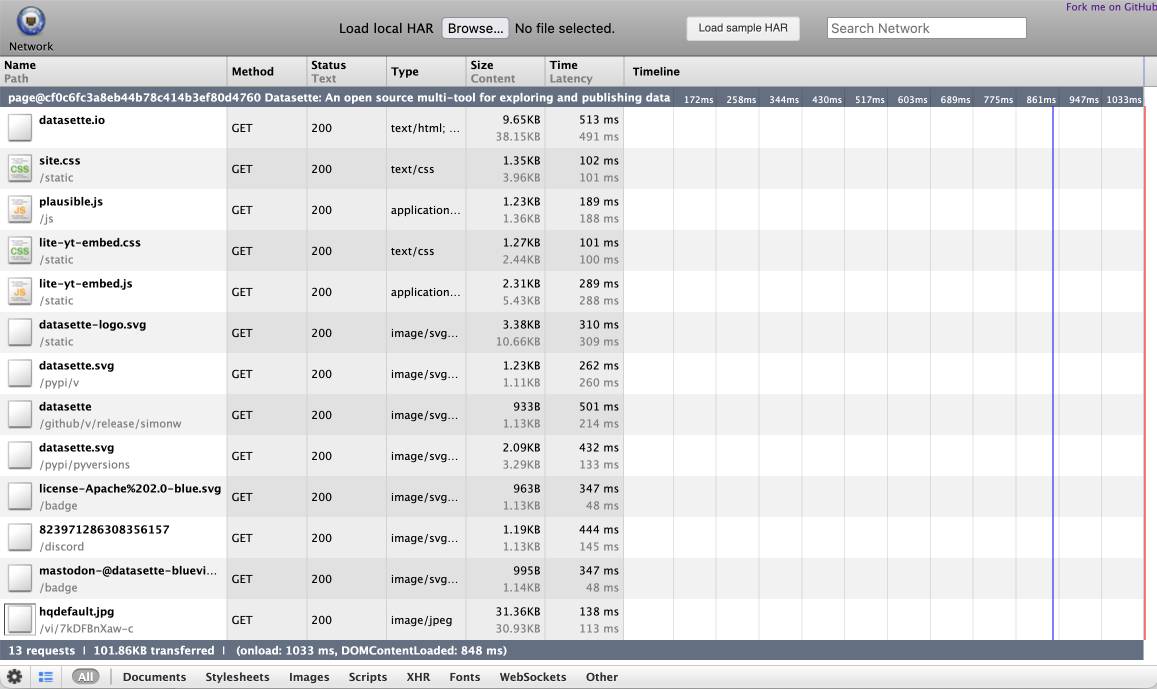
That JSON includes full copies of all of the responses, base64 encoded if they are binary files such as images.
You can add the --zip flag to instead get a datasette-io.har.zip file, containing JSON data in har.har but with the response bodies saved as separate files in that archive.
The shot-scraper multi command lets you run shot-scraper against multiple URLs in sequence, specified using a YAML file. That command now takes a --har option (or --har-zip or --har-file name-of-file), described in the documentation, which will produce a HAR at the same time as taking the screenshots.
Shots are usually defined in YAML that looks like this:
- output: example.com.png
url: http://www.example.com/
- output: w3c.org.png
url: https://www.w3.org/You can now omit the output: keys and generate a HAR file without taking any screenshots at all:
- url: http://www.example.com/
- url: https://www.w3.org/Run like this:
shot-scraper multi shots.yml --har
Which outputs:
Skipping screenshot of 'https://www.example.com/'
Skipping screenshot of 'https://www.w3.org/'
Wrote to HAR file: trace.har
shot-scraper is built on top of Playwright, and the new features use the browser.new_context(record_har_path=...) parameter.
python-build-standalone now has Python 3.14.0a5. Exciting news from Charlie Marsh:
We just shipped the latest Python 3.14 alpha (3.14.0a5) to uv and python-build-standalone. This is the first release that includes the tail-calling interpreter.
Our initial benchmarks show a ~20-30% performance improvement across CPython.
This is an optimization that was first discussed in faster-cpython in January 2024, then landed earlier this month by Ken Jin and included in the 3.14a05 release. The alpha release notes say:
A new type of interpreter based on tail calls has been added to CPython. For certain newer compilers, this interpreter provides significantly better performance. Preliminary numbers on our machines suggest anywhere from -3% to 30% faster Python code, and a geometric mean of 9-15% faster on pyperformance depending on platform and architecture. The baseline is Python 3.14 built with Clang 19 without this new interpreter.
This interpreter currently only works with Clang 19 and newer on x86-64 and AArch64 architectures. However, we expect that a future release of GCC will support this as well.
Including this in python-build-standalone means it's now trivial to try out via uv. I upgraded to the latest uv like this:
pip install -U uvThen ran uv python list to see the available versions:
cpython-3.14.0a5+freethreaded-macos-aarch64-none <download available>
cpython-3.14.0a5-macos-aarch64-none <download available>
cpython-3.13.2+freethreaded-macos-aarch64-none <download available>
cpython-3.13.2-macos-aarch64-none <download available>
cpython-3.13.1-macos-aarch64-none /opt/homebrew/opt/python@3.13/bin/python3.13 -> ../Frameworks/Python.framework/Versions/3.13/bin/python3.13
I downloaded the new alpha like this:
uv python install cpython-3.14.0a5And tried it out like so:
uv run --python 3.14.0a5 pythonThe Astral team have been using Ken's bm_pystones.py benchmarks script. I grabbed a copy like this:
wget 'https://gist.githubusercontent.com/Fidget-Spinner/e7bf204bf605680b0fc1540fe3777acf/raw/fa85c0f3464021a683245f075505860db5e8ba6b/bm_pystones.py'And ran it with uv:
uv run --python 3.14.0a5 bm_pystones.pyGiving:
Pystone(1.1) time for 50000 passes = 0.0511138
This machine benchmarks at 978209 pystones/second
Inspired by Charlie's example I decided to try the hyperfine benchmarking tool, which can run multiple commands to statistically compare their performance. I came up with this recipe:
brew install hyperfine
hyperfine \
"uv run --python 3.14.0a5 bm_pystones.py" \
"uv run --python 3.13 bm_pystones.py" \
-n tail-calling \
-n baseline \
--warmup 10![Running that command produced: Benchmark 1: tail-calling Time (mean ± σ): 71.5 ms ± 0.9 ms [User: 65.3 ms, System: 5.0 ms] Range (min … max): 69.7 ms … 73.1 ms 40 runs Benchmark 2: baseline Time (mean ± σ): 79.7 ms ± 0.9 ms [User: 73.9 ms, System: 4.5 ms] Range (min … max): 78.5 ms … 82.3 ms 36 runs Summary tail-calling ran 1.12 ± 0.02 times faster than baseline](https://static.simonwillison.net/static/2025/hyperfine-uv.jpg)
So 3.14.0a5 scored 1.12 times faster than 3.13 on the benchmark (on my extremely overloaded M2 MacBook Pro).
URL-addressable Pyodide Python environments
This evening I spotted an obscure bug in Datasette, using Datasette Lite. I figure it’s a good opportunity to highlight how useful it is to have a URL-addressable Python environment, powered by Pyodide and WebAssembly.
[... 1,905 words]Nomic Embed Text V2: An Open Source, Multilingual, Mixture-of-Experts Embedding Model (via) Nomic continue to release the most interesting and powerful embedding models. Their latest is Embed Text V2, an Apache 2.0 licensed multi-lingual 1.9GB model (here it is on Hugging Face) trained on "1.6 billion high-quality data pairs", which is the first embedding model I've seen to use a Mixture of Experts architecture:
In our experiments, we found that alternating MoE layers with 8 experts and top-2 routing provides the optimal balance between performance and efficiency. This results in 475M total parameters in the model, but only 305M active during training and inference.
I first tried it out using uv run like this:
uv run \
--with einops \
--with sentence-transformers \
--python 3.13 pythonThen:
from sentence_transformers import SentenceTransformer model = SentenceTransformer("nomic-ai/nomic-embed-text-v2-moe", trust_remote_code=True) sentences = ["Hello!", "¡Hola!"] embeddings = model.encode(sentences, prompt_name="passage") print(embeddings)
Then I got it working on my laptop using the llm-sentence-tranformers plugin like this:
llm install llm-sentence-transformers
llm install einops # additional necessary package
llm sentence-transformers register nomic-ai/nomic-embed-text-v2-moe --trust-remote-code
llm embed -m sentence-transformers/nomic-ai/nomic-embed-text-v2-moe -c 'string to embed'
This outputs a 768 item JSON array of floating point numbers to the terminal. These are Matryoshka embeddings which means you can truncate that down to just the first 256 items and get similarity calculations that still work albeit slightly less well.
To use this for RAG you'll need to conform to Nomic's custom prompt format. For documents to be searched:
search_document: text of document goes here
And for search queries:
search_query: term to search for
I landed a new --prepend option for the llm embed-multi command to help with that, but it's not out in a full release just yet. (Update: it's now out in LLM 0.22.)
I also released llm-sentence-transformers 0.3 with some minor improvements to make running this model more smooth.
llm-sort (via) Delightful LLM plugin by Evangelos Lamprou which adds the ability to perform "semantic search" - allowing you to sort the contents of a file based on using a prompt against an LLM to determine sort order.
Best illustrated by these examples from the README:
llm sort --query "Which names is more suitable for a pet monkey?" names.txt
cat titles.txt | llm sort --query "Which book should I read to cook better?"
It works using this pairwise prompt, which is executed multiple times using Python's sorted(documents, key=functools.cmp_to_key(compare_callback)) mechanism:
Given the query:
{query}
Compare the following two lines:
Line A:
{docA}
Line B:
{docB}
Which line is more relevant to the query? Please answer with "Line A" or "Line B".
From the lobste.rs comments, Cole Kurashige:
I'm not saying I'm prescient, but in The Before Times I did something similar with Mechanical Turk
This made me realize that so many of the patterns we were using against Mechanical Turk a decade+ ago can provide hints about potential ways to apply LLMs.
Using pip to install a Large Language Model that’s under 100MB
I just released llm-smollm2, a new plugin for LLM that bundles a quantized copy of the SmolLM2-135M-Instruct LLM inside of the Python package.
[... 1,553 words]sqlite-s3vfs (via) Neat open source project on the GitHub organisation for the UK government's Department for Business and Trade: a "Python virtual filesystem for SQLite to read from and write to S3."
I tried out their usage example by running it in a Python REPL with all of the dependencies
uv run --python 3.13 --with apsw --with sqlite-s3vfs --with boto3 python
It worked as advertised. When I listed my S3 bucket I found it had created two files - one called demo.sqlite/0000000000 and another called demo.sqlite/0000000001, both 4096 bytes because each one represented a SQLite page.
The implementation is just 200 lines of Python, implementing a new SQLite Virtual Filesystem on top of apsw.VFS.
The README includes this warning:
No locking is performed, so client code must ensure that writes do not overlap with other writes or reads. If multiple writes happen at the same time, the database will probably become corrupt and data be lost.
I wonder if the conditional writes feature added to S3 back in November could be used to protect against that happening. Tricky as there are multiple files involved, but maybe it (or a trick like this one) could be used to implement some kind of exclusive lock between multiple processes?
APSW SQLite query explainer. Today I found out about APSW's (Another Python SQLite Wrapper, in constant development since 2004) apsw.ext.query_info() function, which takes a SQL query and returns a very detailed set of information about that query - all without executing it.
It actually solves a bunch of problems I've wanted to address in Datasette - like taking an arbitrary query and figuring out how many parameters (?) it takes and which tables and columns are represented in the result.
I tried it out in my console (uv run --with apsw python) and it seemed to work really well. Then I remembered that the Pyodide project includes WebAssembly builds of a number of Python C extensions and was delighted to find apsw on that list.
... so I got Claude to build me a web interface for trying out the function, using Pyodide to run a user's query in Python in their browser via WebAssembly.
Claude didn't quite get it in one shot - I had to feed it the URL to a more recent Pyodide and it got stuck in a bug loop which I fixed by pasting the code into a fresh session.
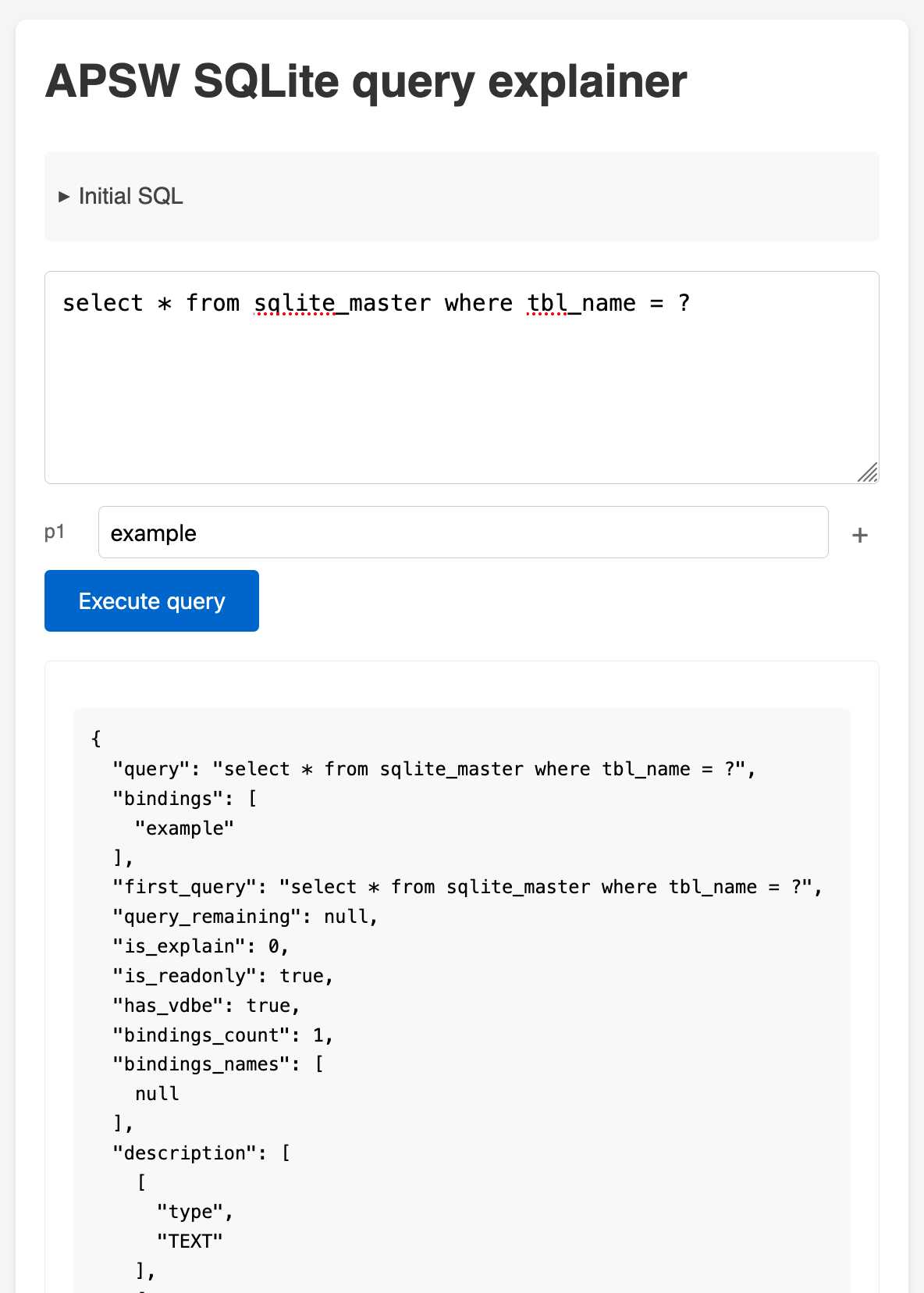
llm-anthropic.
I've renamed my llm-claude-3 plugin to llm-anthropic, on the basis that Claude 4 will probably happen at some point so this is a better name for the plugin.
If you're a previous user of llm-claude-3 you can upgrade to the new plugin like this:
llm install -U llm-claude-3
This should remove the old plugin and install the new one, because the latest llm-claude-3 depends on llm-anthropic. Just installing llm-anthropic may leave you with both plugins installed at once.
There is one extra manual step you'll need to take during this upgrade: creating a new anthropic stored key with the same API token you previously stored under claude. You can do that like so:
llm keys set anthropic --value "$(llm keys get claude)"
I released llm-anthropic 0.12 yesterday with new features not previously included in llm-claude-3:
- Support for Claude's prefill feature, using the new
-o prefill '{'option and the accompanying-o hide_prefill 1option to prevent the prefill from being included in the output text. #2- New
-o stop_sequences '```'option for specifying one or more stop sequences. To specify multiple stop sequences pass a JSON array of strings :-o stop_sequences '["end", "stop"].- Model options are now documented in the README.
If you install or upgrade llm-claude-3 you will now get llm-anthropic instead, thanks to a tiny package on PyPI which depends on the new plugin name. I created that with my pypi-rename cookiecutter template.
Here's the issue for the rename. I archived the llm-claude-3 repository on GitHub, and got to use the brand new PyPI archiving feature to archive the llm-claude-3 project on PyPI as well.
Latest black (25.1.0) adds a newline after docstring and before pass in an exception class.
I filed a bug report against Black when the latest release - 25.1.0 - reformatted the following code to add an ugly (to me) newline between the docstring and the pass:
class ModelError(Exception): "Models can raise this error, which will be displayed to the user" pass
Black maintainer Jelle Zijlstra confirmed that this is intended behavior with respect to Black's 2025 stable style, but also helped me understand that the pass there is actually unnecessary so I can fix the aesthetics by removing that entirely.
I'm linking to this issue because it's a neat example of how I like to include steps-to-reproduce using uvx to create one-liners you can paste into a terminal to see the bug that I'm reporting. In this case I shared the following:
Here's a way to see that happen using
uvx. With the previous Black version:echo 'class ModelError(Exception): "Models can raise this error, which will be displayed to the user" pass' | uvx --with 'black==24.10.0' black -This outputs:
class ModelError(Exception): "Models can raise this error, which will be displayed to the user" pass All done! ✨ 🍰 ✨ 1 file left unchanged.But if you bump to
25.1.0this happens:echo 'class ModelError(Exception): "Models can raise this error, which will be displayed to the user" pass' | uvx --with 'black==25.1.0' black -Output:
class ModelError(Exception): "Models can raise this error, which will be displayed to the user" pass reformatted - All done! ✨ 🍰 ✨ 1 file reformatted.
Via David Szotten I learned that you can use uvx black@25.1.0 here instead.
The surprising way to save memory with BytesIO
(via)
Itamar Turner-Trauring explains that if you have a BytesIO object in Python calling .read() on it will create a full copy of that object, doubling the amount of memory used - but calling .getvalue() returns a bytes object that uses no additional memory, instead using copy-on-write.
.getbuffer() is another memory-efficient option but it returns a memoryview which has less methods than the bytes you get back from .getvalue()- it doesn't have .find() for example.
PyPI now supports project archival. Neat new PyPI feature, similar to GitHub's archiving repositories feature. You can now mark a PyPI project as "archived", making it clear that no new releases are planned (though you can switch back out of that mode later if you need to).
I like the sound of these future plans around this topic:
Project archival is the first step in a larger project, aimed at improving the lifecycle of projects on PyPI. That project includes evaluating additional project statuses (things like "deprecated" and "unmaintained"), as well as changes to PyPI's public APIs that will enable clients to retrieve and act on project status information. You can track our progress on these fronts by following along with warehouse#16844!
We’re building a new static type checker for Python, from scratch, in Rust. From a technical perspective, it’s probably our most ambitious project yet. We’re about 800 PRs deep!
Like Ruff and uv, there will be a significant focus on performance. The entire system is designed to be highly incremental so that it can eventually power a language server (e.g., only re-analyze affected files on code change). [...]
We haven't publicized it to-date, but all of this work has been happening in the open, in the Ruff repository.
A selfish personal argument for releasing code as Open Source
I’m the guest for the most recent episode of the Real Python podcast with Christopher Bailey, talking about Using LLMs for Python Development. We covered a lot of other topics as well—most notably my relationship with Open Source development over the years.
[... 464 words]uv python install --reinstall 3.13.
I couldn't figure out how to upgrade the version of Python 3.13 I had previous installed using uv - I had Python 3.13.0.rc2. Thanks to Charlie Marsh I learned the command for upgrading to the latest uv-supported release:
uv python install --reinstall 3.13
I can confirm it worked using:
uv run --python 3.13 python -c 'import sys; print(sys.version)'
Caveat from Zanie Blue on my PR to document this:
There are some caveats we'd need to document here, like this will break existing tool installations (and other virtual environments) that depend on the version. You'd be better off doing
uv python install 3.13.Xto add the new patch version in addition to the existing one.
Can LLMs write better code if you keep asking them to “write better code”?
(via)
Really fun exploration by Max Woolf, who started with a prompt requesting a medium-complexity Python challenge - "Given a list of 1 million random integers between 1 and 100,000, find the difference between the smallest and the largest numbers whose digits sum up to 30" - and then continually replied with "write better code" to see what happened.
It works! Kind of... it's not quite as simple as "each time round you get better code" - the improvements sometimes introduced new bugs and often leaned into more verbose enterprisey patterns - but the model (Claude in this case) did start digging into optimizations like numpy and numba JIT compilation to speed things up.
I used to find the thing where telling an LLM to "do better" worked completely surprising. I've since come to terms with why it works: LLMs are effectively stateless, so each prompt you execute is considered as an entirely new problem. When you say "write better code" your prompt is accompanied with a copy of the previous conversation, so you're effectively saying "here is some code, suggest ways to improve it". The fact that the LLM itself wrote the previous code isn't really important.
I've been having a lot of fun recently using LLMs for cooking inspiration. "Give me a recipe for guacamole", then "make it tastier" repeated a few times results in some bizarre and fun variations on the theme!
2024
Open WebUI. I tried out this open source (MIT licensed, JavaScript and Python) localhost UI for accessing LLMs today for the first time. It's very nicely done.
I ran it with uvx like this:
uvx --python 3.11 open-webui serve
On first launch it installed a bunch of dependencies and then downloaded 903MB to ~/.cache/huggingface/hub/models--sentence-transformers--all-MiniLM-L6-v2 - a copy of the all-MiniLM-L6-v2 embedding model, presumably for its RAG feature.
It then presented me with a working Llama 3.2:3b chat interface, which surprised me because I hadn't spotted it downloading that model. It turns out that was because I have Ollama running on my laptop already (with several models, including Llama 3.2:3b, already installed) - and Open WebUI automatically detected Ollama and gave me access to a list of available models.
I found a "knowledge" section and added all of the Datasette documentation (by dropping in the .rst files from the docs) - and now I can type # in chat to search for a file, add that to the context and then ask questions about it directly.
I selected the spatialite.rst.txt file, prompted it with "How do I use SpatiaLite with Datasette" and got back this:
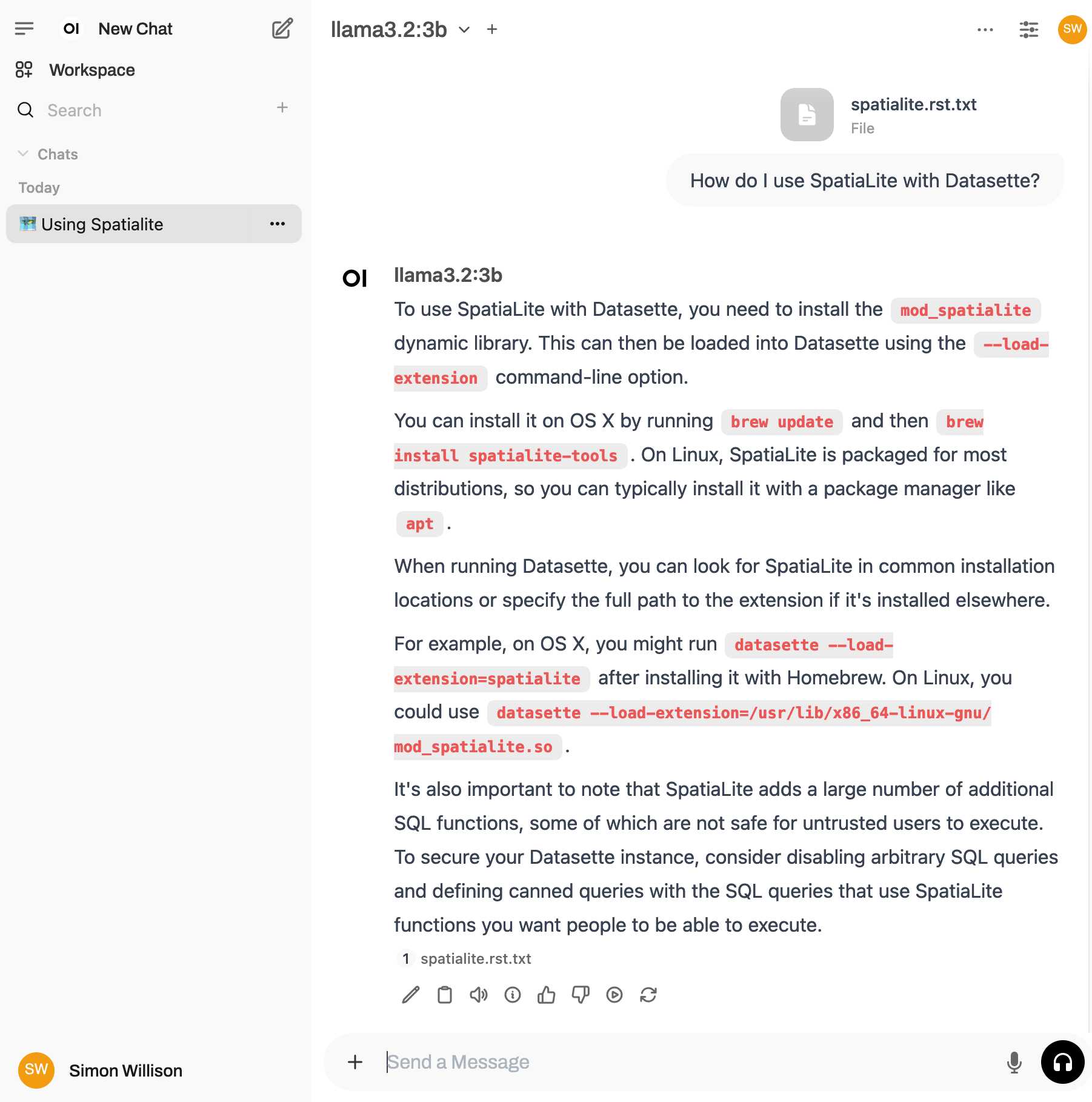
That's honestly a very solid answer, especially considering the Llama 3.2 3B model from Ollama is just a 1.9GB file! It's impressive how well that model can handle basic Q&A and summarization against text provided to it - it somehow has a 128,000 token context size.
Open WebUI has a lot of other tricks up its sleeve: it can talk to API models such as OpenAI directly, has optional integrations with web search and custom tools and logs every interaction to a SQLite database. It also comes with extensive documentation.
Trying out QvQ—Qwen’s new visual reasoning model
I thought we were done for major model releases in 2024, but apparently not: Alibaba’s Qwen team just dropped the Apache 2.0 licensed Qwen licensed (the license changed) QvQ-72B-Preview, “an experimental research model focusing on enhancing visual reasoning capabilities”.
Finally, a replacement for BERT: Introducing ModernBERT (via) BERT was an early language model released by Google in October 2018. Unlike modern LLMs it wasn't designed for generating text. BERT was trained for masked token prediction and was generally applied to problems like Named Entity Recognition or Sentiment Analysis. BERT also wasn't very useful on its own - most applications required you to fine-tune a model on top of it.
In exploring BERT I decided to try out dslim/distilbert-NER, a popular Named Entity Recognition model fine-tuned on top of DistilBERT (a smaller distilled version of the original BERT model). Here are my notes on running that using uv run.
Jeremy Howard's Answer.AI research group, LightOn and friends supported the development of ModernBERT, a brand new BERT-style model that applies many enhancements from the past six years of advances in this space.
While BERT was trained on 3.3 billion tokens, producing 110 million and 340 million parameter models, ModernBERT trained on 2 trillion tokens, resulting in 140 million and 395 million parameter models. The parameter count hasn't increased much because it's designed to run on lower-end hardware. It has a 8192 token context length, a significant improvement on BERT's 512.
I was able to run one of the demos from the announcement post using uv run like this (I'm not sure why I had to use numpy<2.0 but without that I got an error about cannot import name 'ComplexWarning' from 'numpy.core.numeric'):
uv run --with 'numpy<2.0' --with torch --with 'git+https://github.com/huggingface/transformers.git' pythonThen this Python:
import torch from transformers import pipeline from pprint import pprint pipe = pipeline( "fill-mask", model="answerdotai/ModernBERT-base", torch_dtype=torch.bfloat16, ) input_text = "He walked to the [MASK]." results = pipe(input_text) pprint(results)
Which downloaded 573MB to ~/.cache/huggingface/hub/models--answerdotai--ModernBERT-base and output:
[{'score': 0.11669921875,
'sequence': 'He walked to the door.',
'token': 3369,
'token_str': ' door'},
{'score': 0.037841796875,
'sequence': 'He walked to the office.',
'token': 3906,
'token_str': ' office'},
{'score': 0.0277099609375,
'sequence': 'He walked to the library.',
'token': 6335,
'token_str': ' library'},
{'score': 0.0216064453125,
'sequence': 'He walked to the gate.',
'token': 7394,
'token_str': ' gate'},
{'score': 0.020263671875,
'sequence': 'He walked to the window.',
'token': 3497,
'token_str': ' window'}]
I'm looking forward to trying out models that use ModernBERT as their base. The model release is accompanied by a paper (Smarter, Better, Faster, Longer: A Modern Bidirectional Encoder for Fast, Memory Efficient, and Long Context Finetuning and Inference) and new documentation for using it with the Transformers library.
Building Python tools with a one-shot prompt using uv run and Claude Projects
I’ve written a lot about how I’ve been using Claude to build one-shot HTML+JavaScript applications via Claude Artifacts. I recently started using a similar pattern to create one-shot Python utilities, using a custom Claude Project combined with the dependency management capabilities of uv.
[... 899 words]